Unstuffed peppers is another one of our favorite recipes made with dehydrated ingredients. Traditionally, it’s a delicious dish with hollowed-out bell peppers filled with various ingredients.
Taking our Dehydrator Chef approach, we will deconstruct the traditional stuffed bell pepper recipe to make it both dehydrator-friendly and also hydration-friendly out in the field.
So let’s get started.
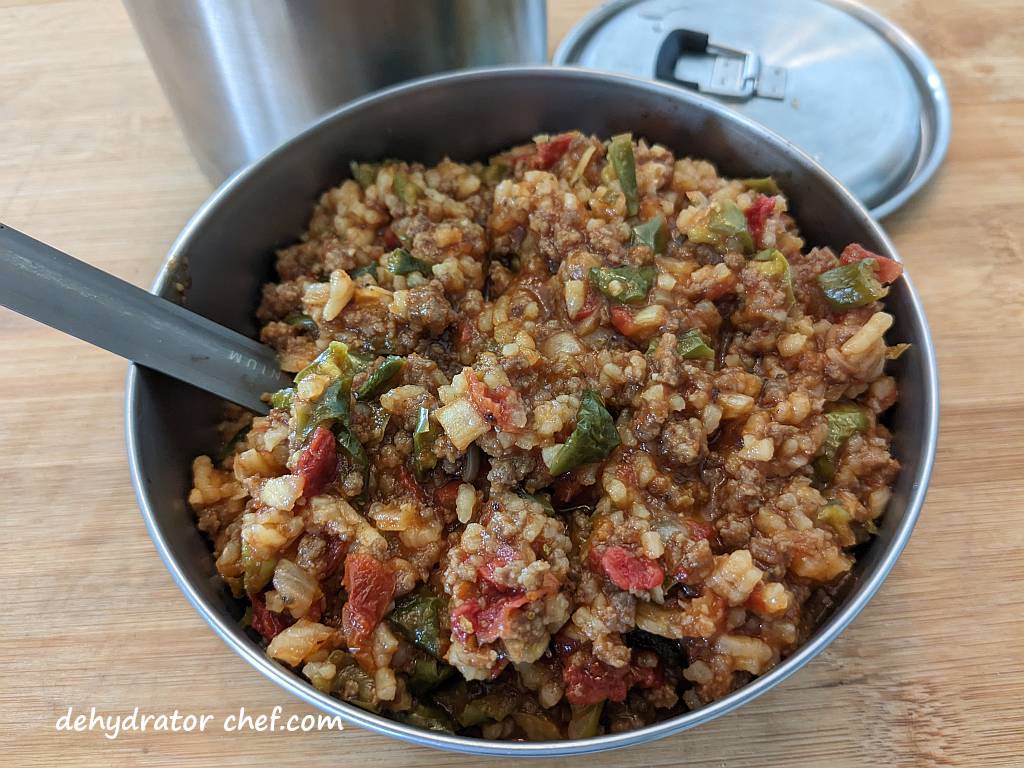
Table of Contents
- Dehydrated Unstuffed Peppers Recipe
- Supplies and Tools Needed for Dehydrated Unstuffed Peppers
- Dehydrated Unstuffed Peppers Dry Ingredients
- Dehydrated Unstuffed Peppers Ingredient Notes
- At-Home Preparation
- Optimize Food Protection for Storage and Travel
- In the Field Preparation
- Dehydrated Unstuffed Peppers Nutrition Information
Dehydrated Unstuffed Peppers Recipe
Dehydrated unstuffed peppers are a versatile, satisfying, and substantial main dish you can customize to suit personal tastes and dietary preferences. Whether you prefer more of a classic recipe or want to explore different flavor combinations, stuffed peppers are a delicious option that everyone can enjoy.
Supplies and Tools Needed for Dehydrated Unstuffed Peppers
- Several 1-quart zip-top bags
- Heavy-duty paper towels
- Labeling materials such as masking tape and waterproof all-weather pen
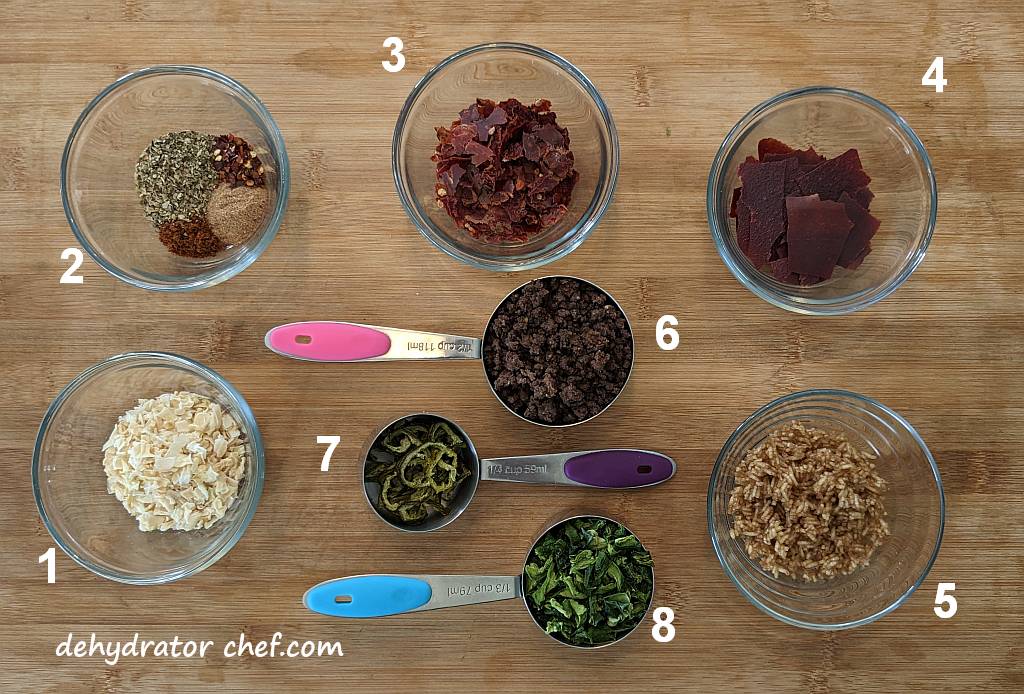
1) dehydrated onion
2) spices, Italian seasoning, crushed red pepper flake, dehydrated beef bouillon, dehydrated chipotle peppers in adobo sauce
3) dehydrated RoTel diced tomatoes
4) dehydrated tomato sauce
5) dehydrated white rice made with beef stock
6) dehydrated ground beef
7) dehydrated pickled jalapeno slices
8) dehydrated green peppers
With some pre-planning, making your own dehydrated camping food is easy.
Dehydrated Unstuffed Peppers Dry Ingredients
Makes one serving, approximately 160 grams, or 1-1/2 to 2 cups of dry mix.
- 45 grams dehydrated ground beef crumbles
- 20 grams dehydrated green, red, or yellow bell pepper
- 10 grams dehydrated RoTel Diced Tomatoes with Green Chilies
- 20 grams dehydrated tomato sauce
- 40 grams dehydrated white rice cooked in beef stock
- 15 grams dehydrated onions
- 1 teaspoon Italian seasoning
- 1 tablespoon dehydrated bouillon powder
- 1/4 teaspoon crushed red pepper flakes
- 1/2 teaspoon freshly ground black pepper to taste
- 3 grams dehydrated chipotle peppers in adobo sauce (optional)
- 3 grams dehydrated jalapeno pepper slices (optional)
Dehydrated Unstuffed Peppers Ingredient Notes
We suggest you make this recipe at home several times before you head out to the field so you can dial it into your personal preferences. Adjusting proteins, carbohydrates, and spices as you see fit.
At-Home Preparation
Combine all the dry ingredients into a food-safe 1-quart quality name-brand zip-top bag for best storage results. The sharp edges of dehydrated ingredients could cause micro-punctures in lesser-quality zip-top plastic bags.
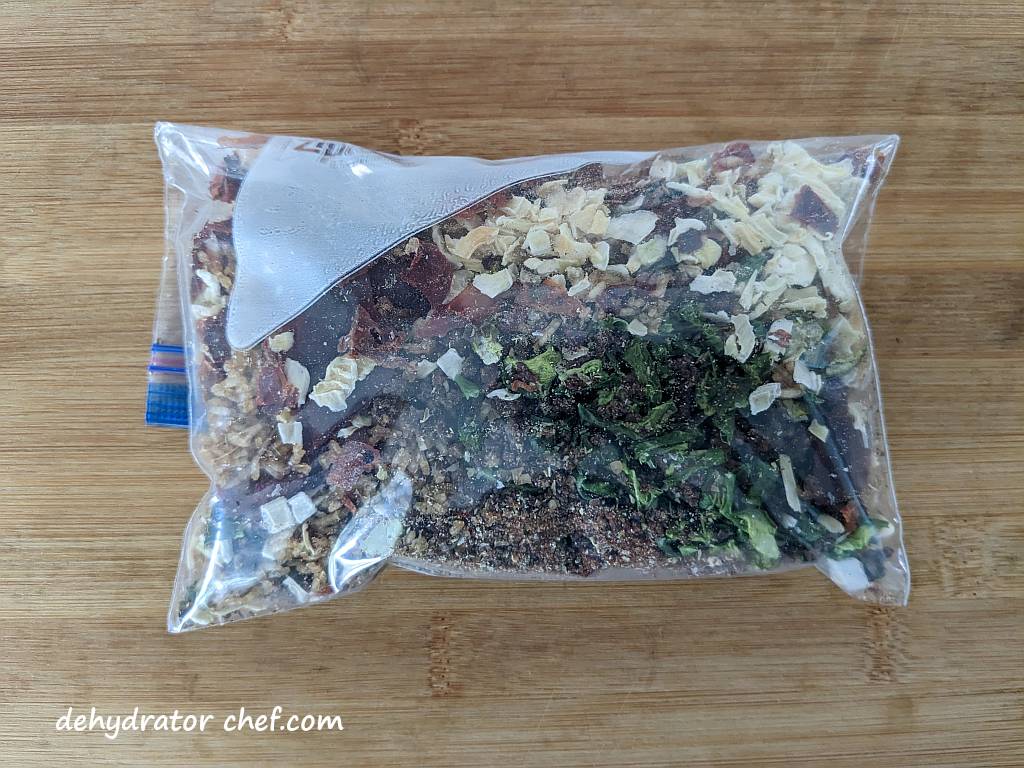
Compared to the local big box stores, Amazon has the best prices for the name-brand 1-quart zip-top bags. So says the 20,000 plus Amazon customer reviewers who took the time to leave feedback. The rough edges and sharp ends of homemade dehydrated ingredients very often compromise generic zip-top bags. Quality zip-top bags are a necessity when making dehydrated meals for camping.
Be sure to include a short note with the name of the dish and detailed preparation instructions. We have included detailed preparation instructions for this dehydrated unstuffed peppers recipe at the end of this page.
Optimize Food Protection for Storage and Travel
Double bagging, using two zip-top bags with a separator, is an option to help guard against punctures, leaks, and water penetration and to protect the food’s integrity. This way, it remains viable in the field or pantry storage.
The Scott Shop towels brand makes an excellent bag separator. These multipurpose paper towels are thicker than the average heavy-duty paper towel. As a multitasker, repurpose these towels for the after-meal cleanup activities.

These heavy-duty paper towels have over 11,000 Amazon customer reviews with an average rating of 4.8 out of 5 stars, which is evidence of a great product. You may be able to find them at your local big-box megamart automotive department.
In the Field Preparation
Empty the contents of the zip-top bag into a suitable-sized cooking pot.
Measure in enough water to cover the dry ingredients. Then add a tad bit more water. Stir to mix thoroughly. Cover, and let the dry ingredients hydrate for at least five minutes. Stir several times, and add more water if needed to keep the ingredients covered and well-saturated.
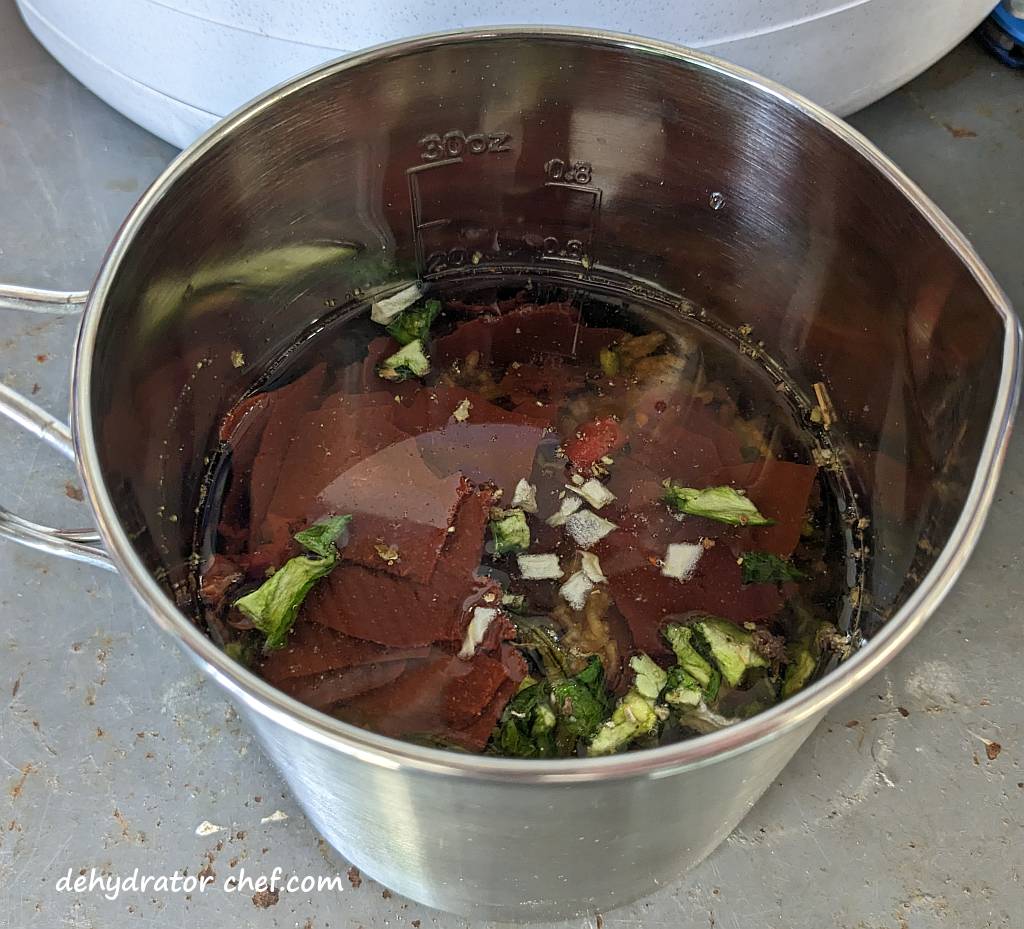
The next step is to add a bit more water; this part is more art than it is science. Depending on your cooking pot’s size and style, you’ll need to gauge how much additional water to add to the hydrated mix. The mix should remain fully covered with water.
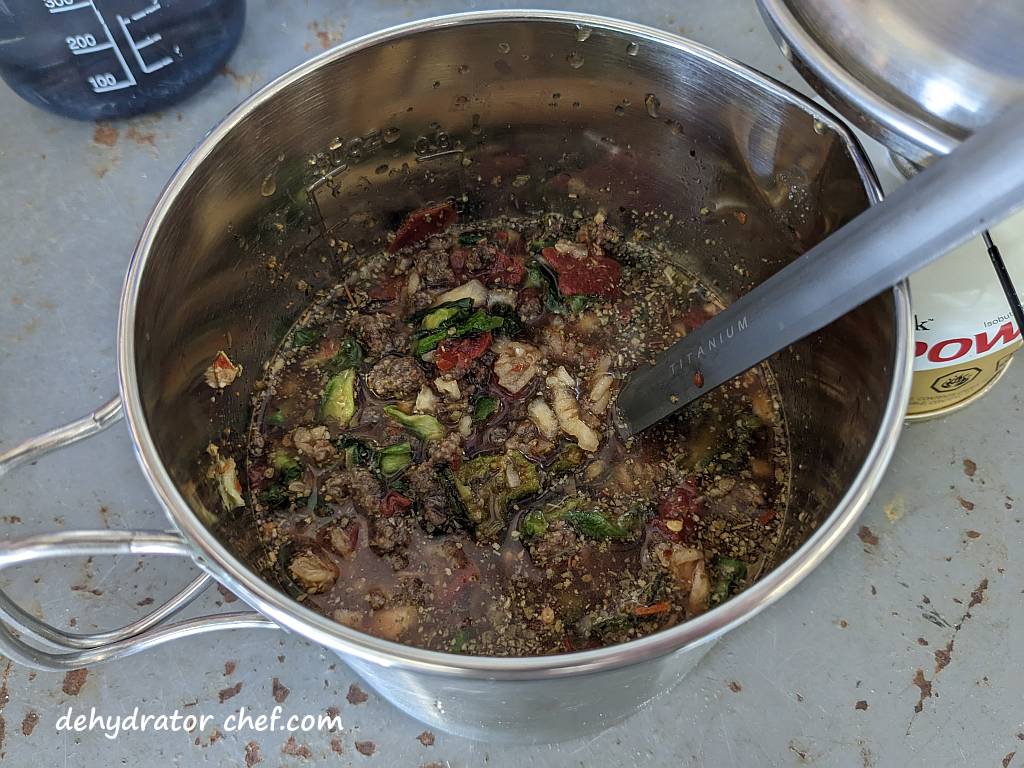
So why not add all of the water at once? You certainly can, but we are metering in the water, so we don’t end up with a soupy product.
Practice these Dehydrator Chef homemade dehydrated camping meal recipes at home several times with the very same outdoor kitchen gear used in the field or at the campsite. This approach lets you practice your skills to know what to expect and where to adapt.
Next, on your cooking stove and over medium flame, bring the hydrating mix to a boil, frequently stirring to mix. After coming to a boil, if your stove is capable of a low-heat simmer, turn the flame down to reduce the chance of burning.
After two or more minutes of simmering, stirring, and mixing the ingredients, turn off the stove and move the pot into an insulated wrap or cozy to rest and hydrate for at least 15 to 20 minutes more for the flavors to blend and the ingredients to fully reconstitute.
Add any remaining seasonings, like freshly ground black pepper or hot sauce, for added spice and flavor.
If desired, incorporate olive or avocado oil into the mixture. The additional fat complements the flavor profile, compensating for the absence of the unique taste associated with fat. The fat enhances taste and promotes a sense of fullness more quickly.
Dehydrated Unstuffed Peppers Nutrition Information
Nutrition information is only an estimate. The nutrition information of this recipe may differ depending on the ingredients you use.
Approximate Serving Size: 160 grams | Calories: 683kcal | Total Fat: 9g | Saturated Fat: 4g | Cholesterol: 70mg | Sodium: 317mg | Carbohydrate: 110g | Dietary Fiber: 17g | Sugar: 36g| Protein: 41g
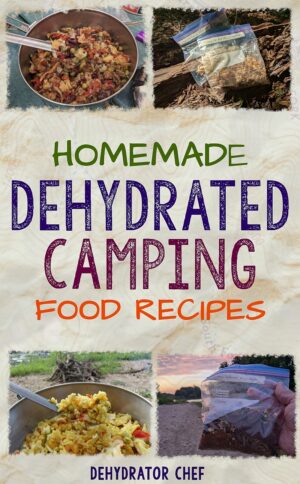 | The Dehydrator Chef Book Available only on Amazon.com You’ll find step-by-step instructions for 26 homemade dehydrated camping meals. Many recipes are only available in this book. Grab yourself a copy today. |

Dehydrated Unstuffed Peppers
Equipment
- Labeling materials (masking tape, waterproof all-weather pen)
Ingredients
Dry Ingredients
- 45 grams dehydrated ground beef crumbles
- 20 grams dehydrated bell peppers (use, green, red, or yellow peppers)
- 15 grams dehydrated RoTel Diced Tomatoes with Green Chilies
- 20 grams dehydrated tomato sauce
- 40 grams dehydrated white rice (made with beef stock)
- 15 grams dehydrated onion
- 1 teaspoon Italian seasoning
- 1 tablespoon dehydrated bouillon powder
- 1/4 teaspoon crushed red pepper flakes
- 1/2 teaspoon freshly ground black pepper
- 3 grams dehydrated chipotle peppers in adobo sauce (optional)
- 3 grams dehydrated jalapeno pepper slices (optional)
Wet Ingredients
- quality cooking oil, such as avocado or olive oil (stored in a leak-proof container)
Instructions
At Home Preparation
- Add the dry ingredients to a food-safe 1-quart quality name-brand zip-top bag. Label the zip-top with the contents and the date.45 grams dehydrated ground beef crumbles, 20 grams dehydrated bell peppers, 15 grams dehydrated RoTel Diced Tomatoes with Green Chilies, 20 grams dehydrated tomato sauce, 15 grams dehydrated onion, 3 grams dehydrated jalapeno pepper slices
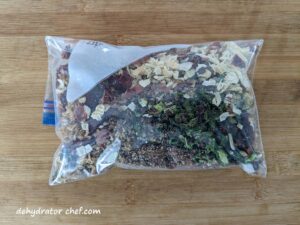
- Store the leak-proof container of cooking oil in your cooking pot or with your camp kitchen spices and condiment packets.
Packaging
- Wrap the zip-top bag with a heavy-duty paper towel to help guard against punctures, leaks, and water penetration due to the sharp edges of the dehydrated ingredients and to protect the food's integrity. This way, it remains viable in the field or pantry storage.
- Add the paper towel wrapped dry mix bag to the last food-safe 1-quart quality name-brand zip-top bag and label it with the contents and the date.
In the Field Preparation
- Empty the dry mix contents of the zip-top bag into a suitable-sized cooking pot.
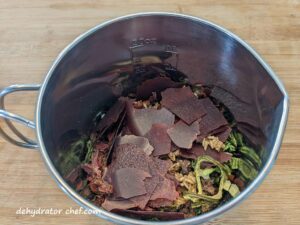
- Add enough water to cover the dry ingredients. Then add a tad bit more water. Stir to mix thoroughly. Cover, and let the dry ingredients hydrate for a minimum of five minutes.

- Next, on your cooking stove and over medium flame, bring the hydrating mix to a boil, frequently stirring to mix. After coming to a boil, turn the flame down to a simmer to reduce the chance of burning.
- After two or more minutes of simmering and stirring, turn off the stove and move the pot into an insulated wrap or cozy to rest, hydrate, and steam for 15 to 20 minutes or more for the flavors to blend and the ingredients to fully reconstitute.
- If desired, add a bit of the healthy cooking oil from the leak-proof container. Stir to combine.quality cooking oil, such as avocado or olive oil
Notes
Nutrition
Nutrition information is only an estimate and may differ depending on the ingredients you use.
Dehydrated Unstuffed Peppers Detailed Preparation Instructions
Equipment
- camp kitchen equipment (including camping stove, cooking pot, utensils, etc.)
Materials
- 1 serving dehydrated unstuffed peppers
Instructions
- Empty the dehydrated unstuffed peppers dry mix contents of the zip-top bag into your cooking pot.
- Pour in enough water to cover the dry mix, then add a tad bit more.
- Cover, and let the dry ingredients hydrate in your camp cookware for at least five minutes. Stir all of the way to the bottom now and again.
- Next, on your cooking stove and over a medium flame, bring the dry mix to a boil, stirring frequently to prevent burning.
- After bringing the dry mix to a boil, turn the stove down to a low simmer for two minutes.
- After two or more minutes of simmering and stirring, turn off the stove and move the pot into an insulated wrap or cozy to rest and hydrate for 15 to 20 minutes or more for the flavors to blend and the ingredients to fully reconstitute.
- Finally, after the unstuffed peppers have rested for 15 to 20 minutes, add some of the optional cooking oil and stir to mix. Enjoy!

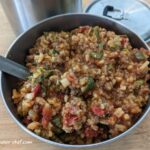
One reply on “Dehydrated Unstuffed Peppers – Making Dehydrated Meals for Camping”
Great recipe, I love stuffed peppers and I’m going to try this one out. But I’ll use red bell peppers because I like them better.